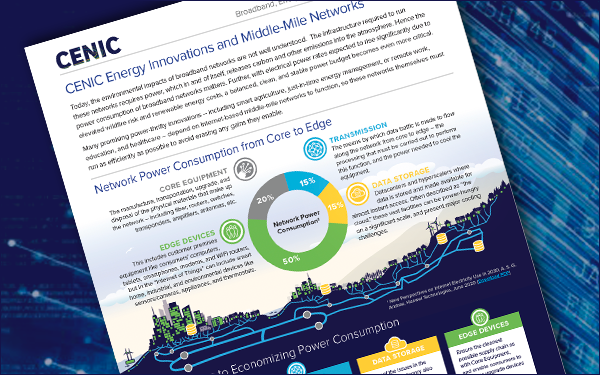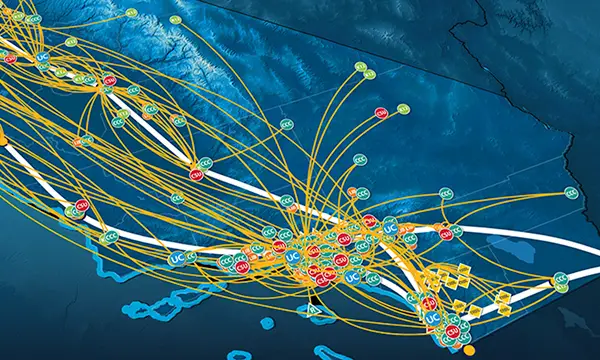- About
- Network
- Community
- Initiatives
- News
- Events
- Blog
- Publications

CA Broadband, Energy, and the Environment Series: the first installment in a new series
Categories RENS & NRENS GOLDENSTATENET Technology & Innovation
The infrastructure required to run broadband networks requires power, which in and of itself releases carbon and other emissions into the atmosphere, so the power consumption of broadband networks matters. Further, with electrical power rates expected to rise significantly due to elevated wildfire risk and renewable energy costs, a balanced, clean, and stable power budget becomes even more critical.
To examine these factors, CENIC is pleased to present the first installment of its California Broadband, Energy, and the Environment Series, examining how middle-mile networks can meet the growing demands of 21st century society while improving their own energy use and enabling energy efficiencies in broadband networks of all kinds.
CENIC Energy Innovations and Middle-Mile Networks

Motivated by a desire to scale for the future while using its and its members’ resources as efficiently as possible, CENIC has achieved dramatic improvements in network-related power, equipment, and service provision.
By implementing power- and process-related efficiencies, CENIC was able to reduce its network power use from 343,000 to 106,000 kWh/month – a major cost savings and reduction in power consumption of over two-thirds and the equivalent of powering 270 households while still increasing capacity for its member communities. DOWNLOAD PDF >
We will continue to release additional installments in this series as we delve into other topics of interest, such as how anchor institutions, researchers, consumers, and last-mile providers can improve their own energy use through the services made available over middle-mile networks.
To learn even more about middle-mile networks including what they are, what they will do for last-mile networks and their customers, the service products they could deliver, how they connect into the existing Internet, and how public and private networks work together, download CENIC’s Middle-Mile Network Series.
Related blog posts
The Big Game Is Big Data: How CENIC and the California Research and Education Network Support Member Athletics
When Fresno State needed to connect to Pac-12 Enterprises to broadcast a live football game over CBS, the Chancellor's Office reached out to CENIC for what Pac-12 later called the smoothest turn-up they've ever experienced.
Enabling Network-Based Collaboration Around the World: A Tour of CENIC and Partner Network Maps
On the Network Maps page at the CENIC website, you’ll find maps of all the networks, peering facilities, and exchanges to which CalREN connects, showing how thousands of CENIC member institutions connect to CalREN and to colleagues all over the globe.


